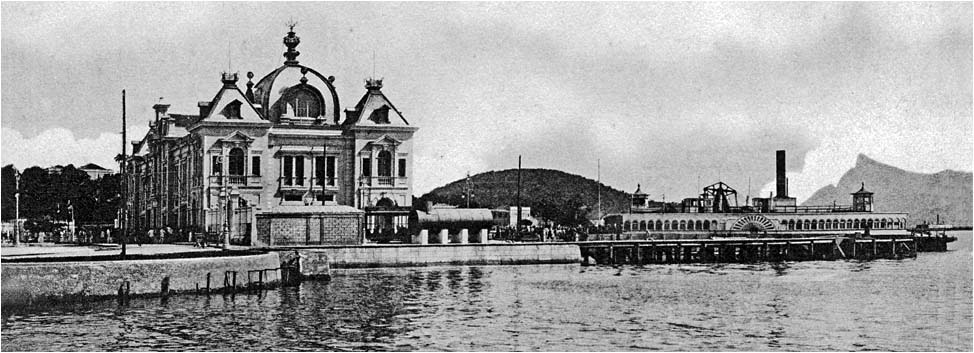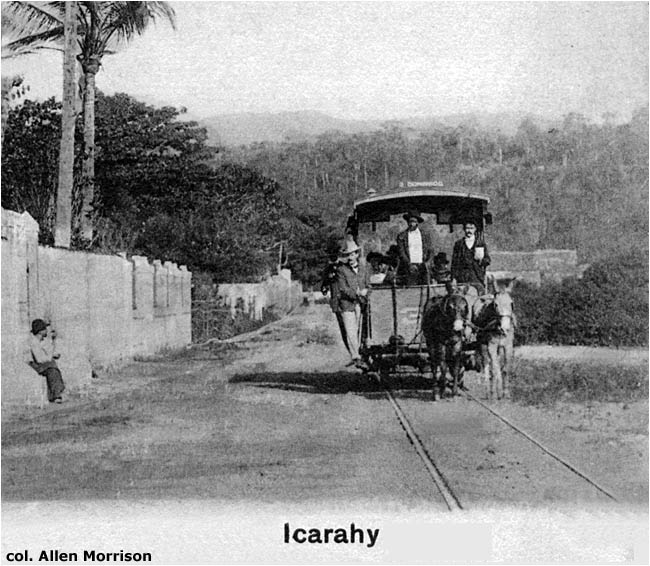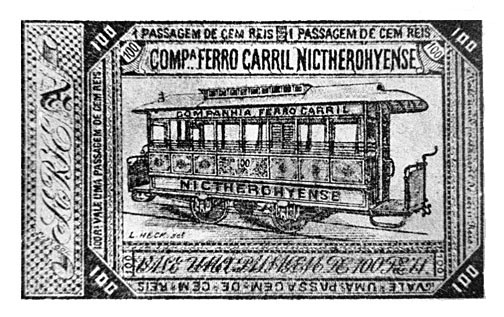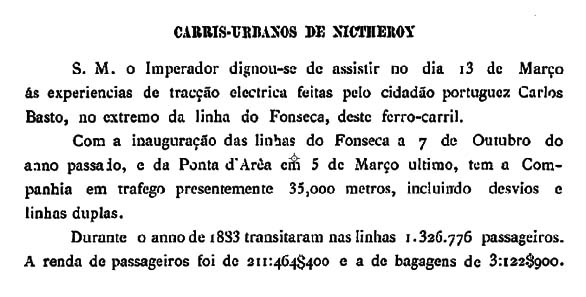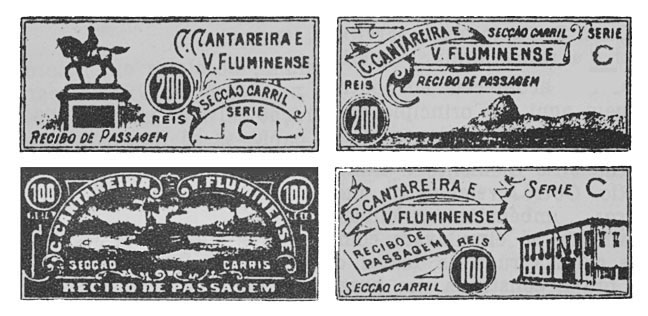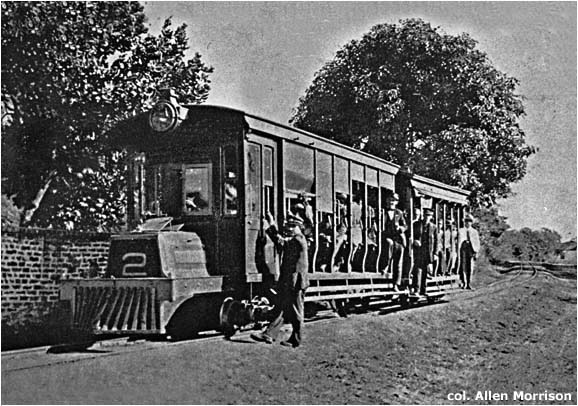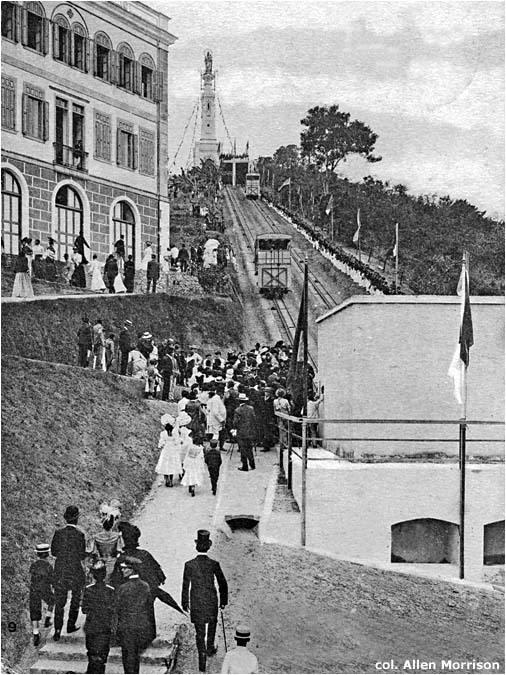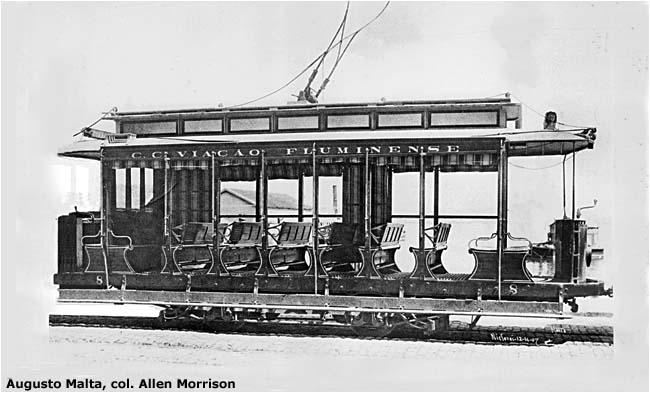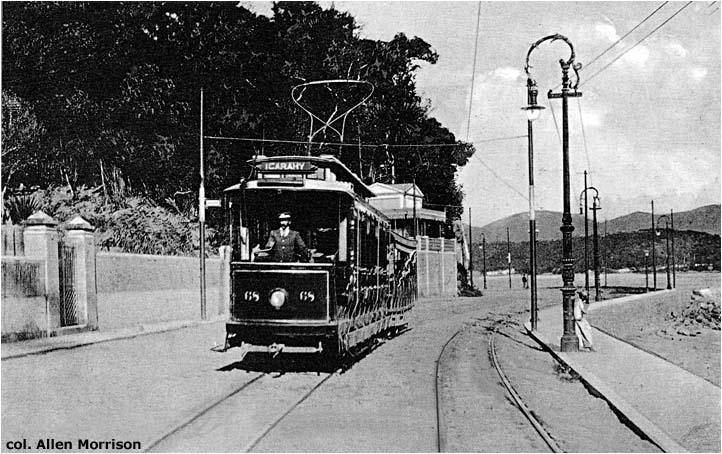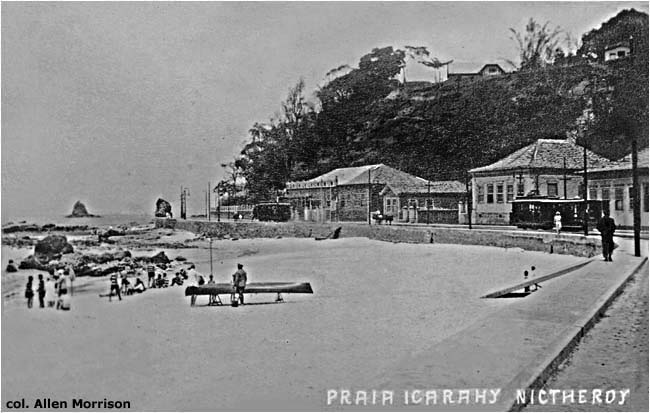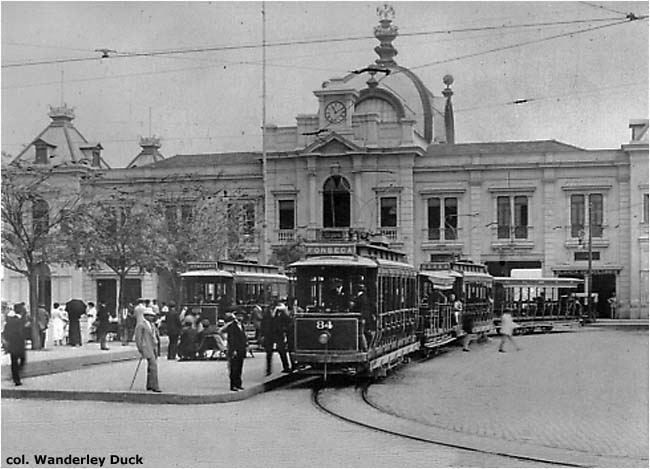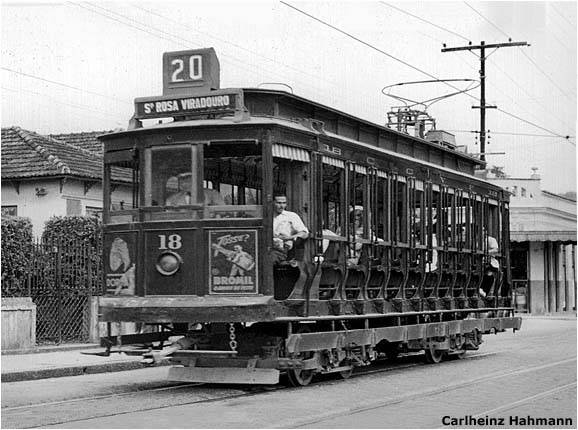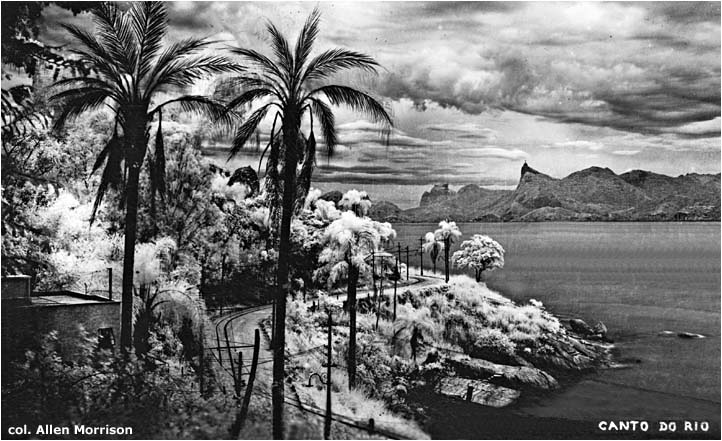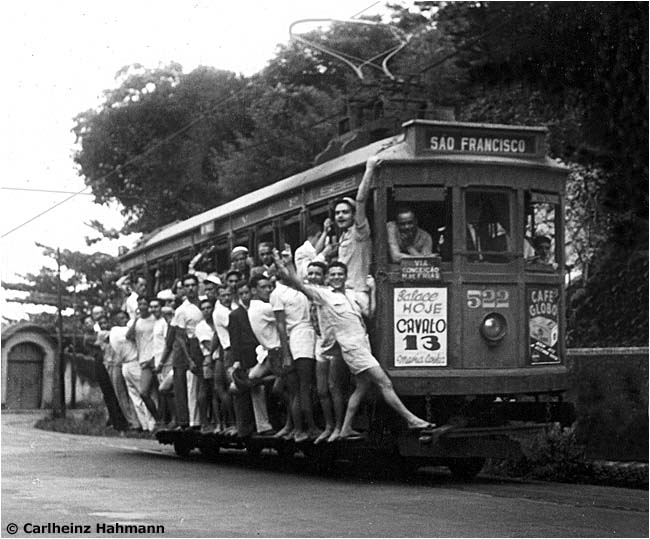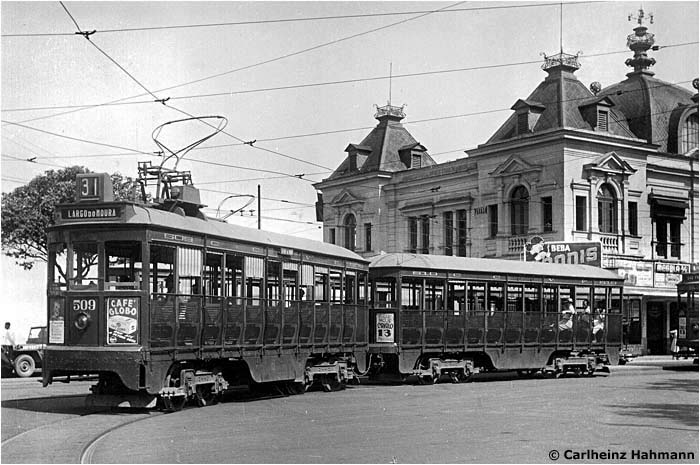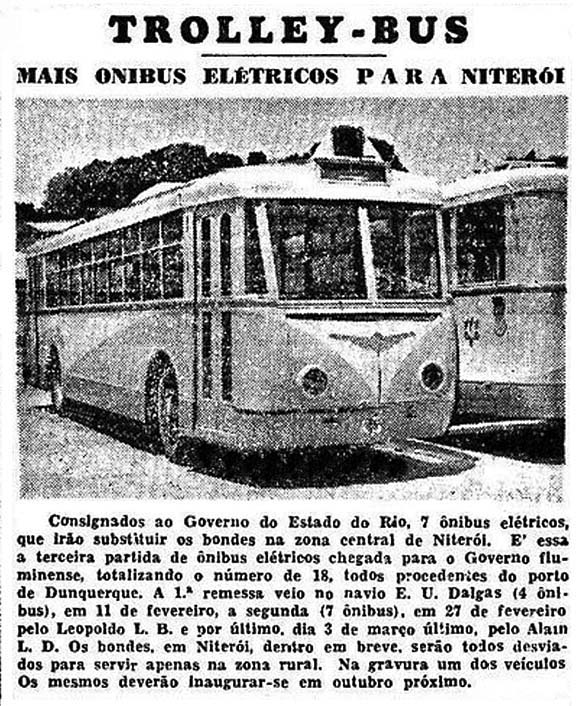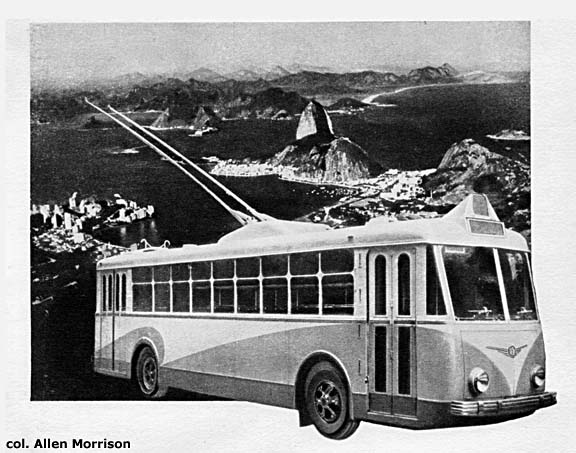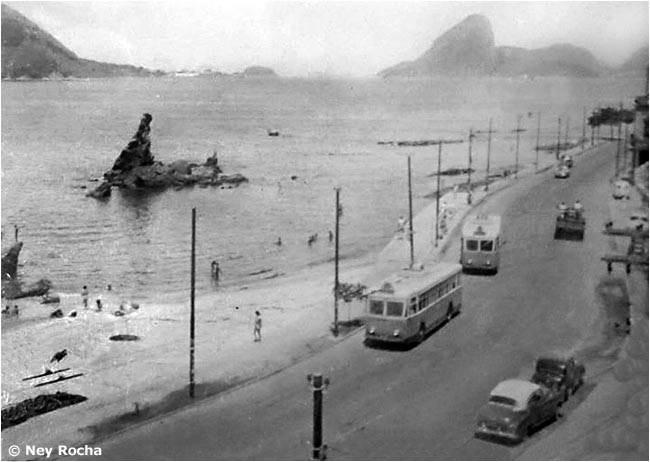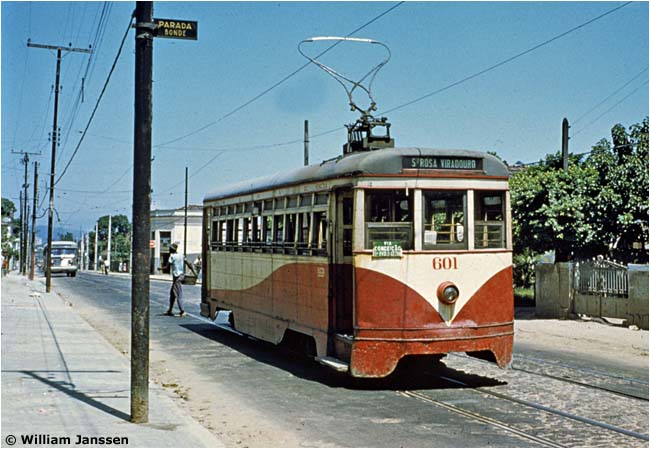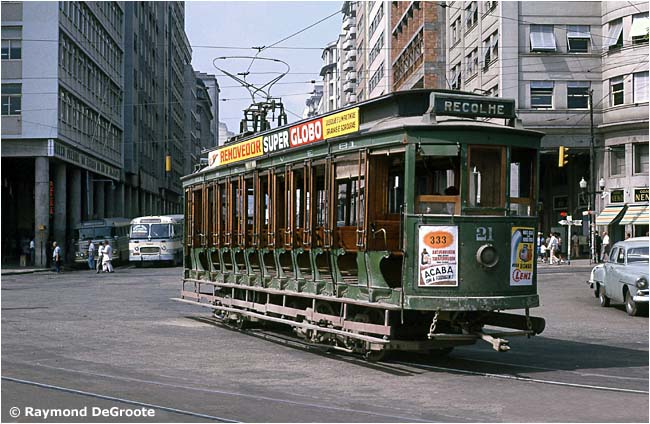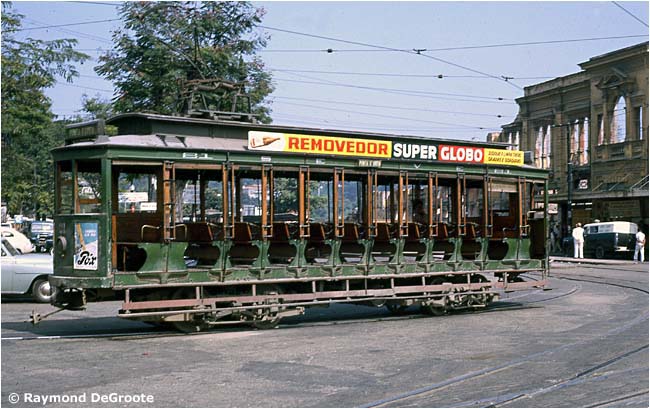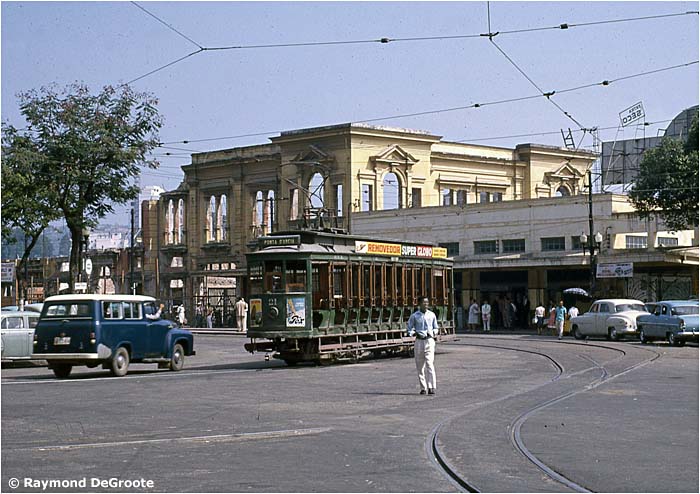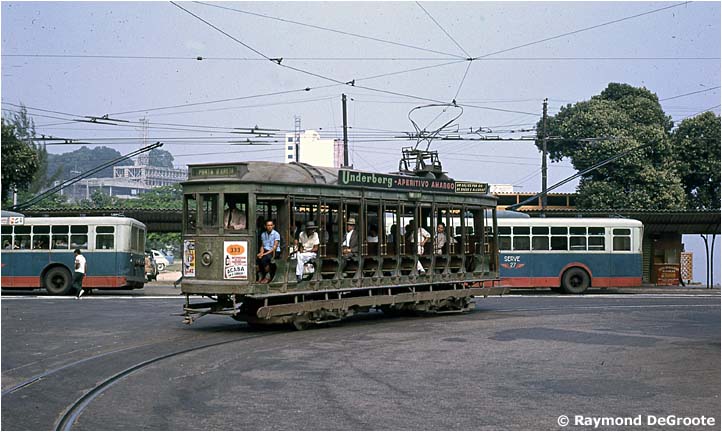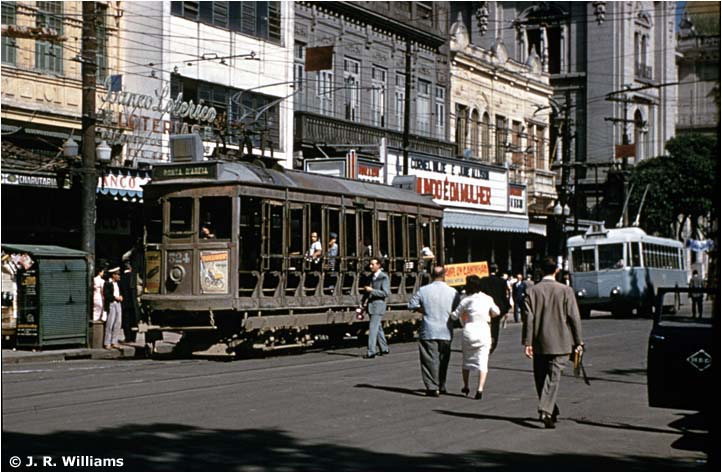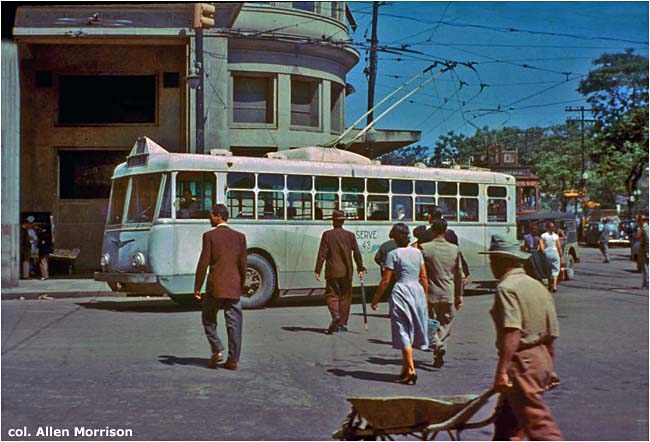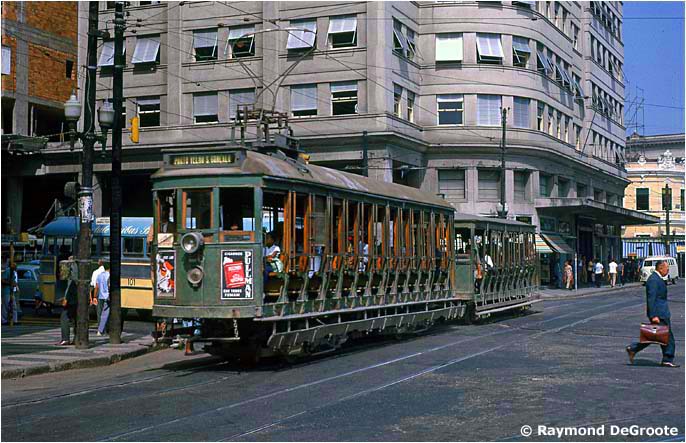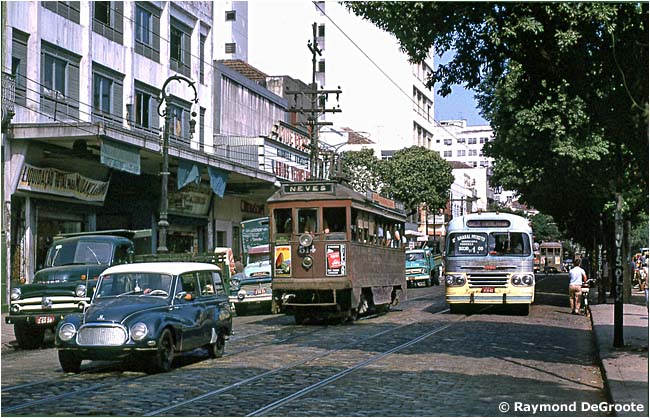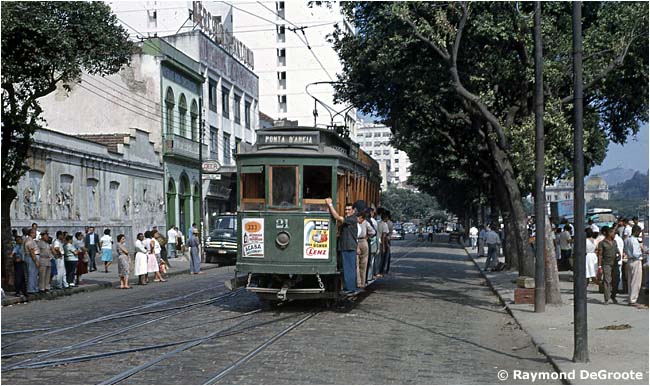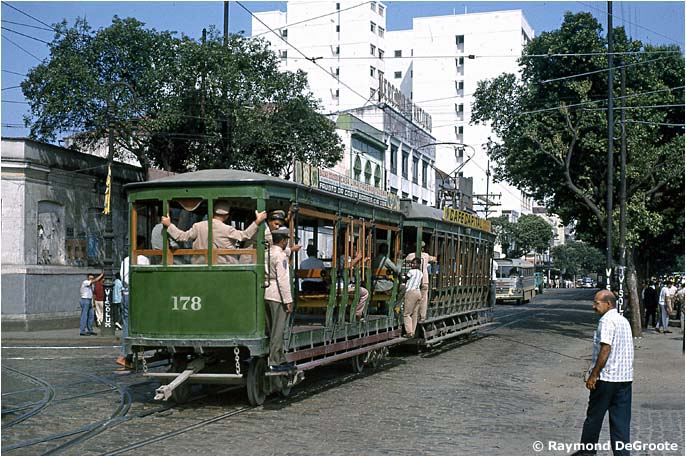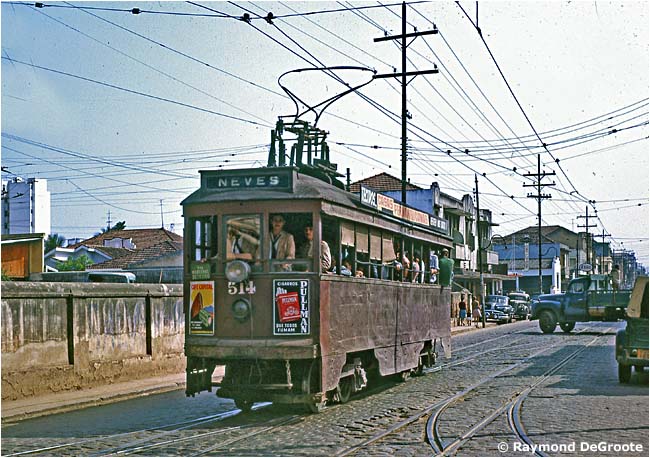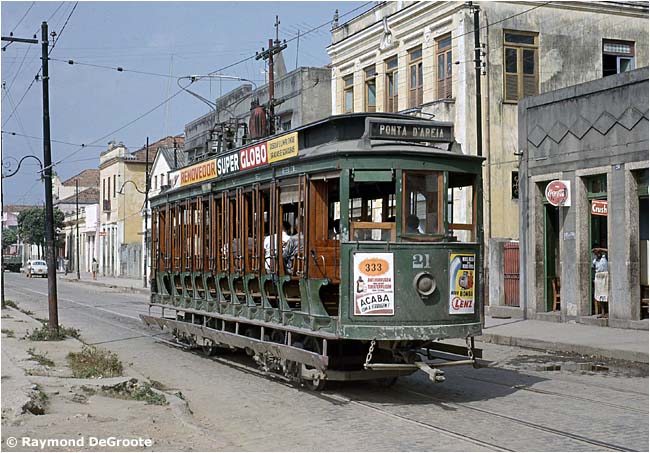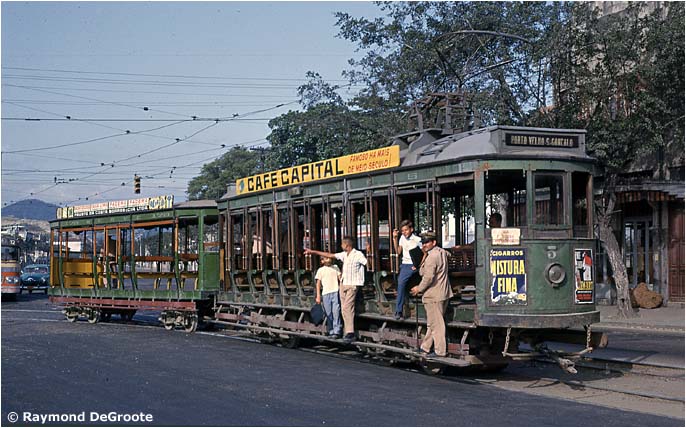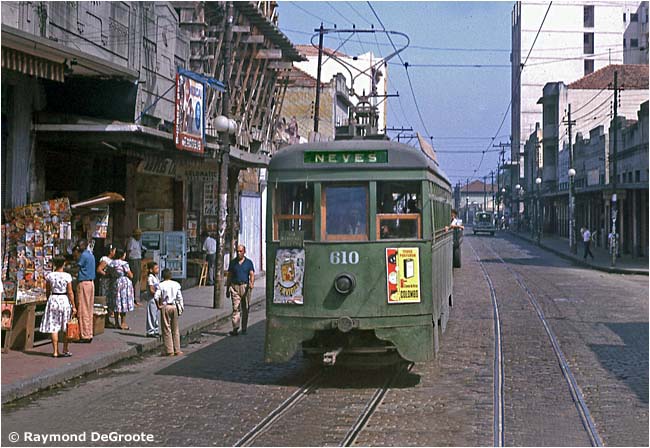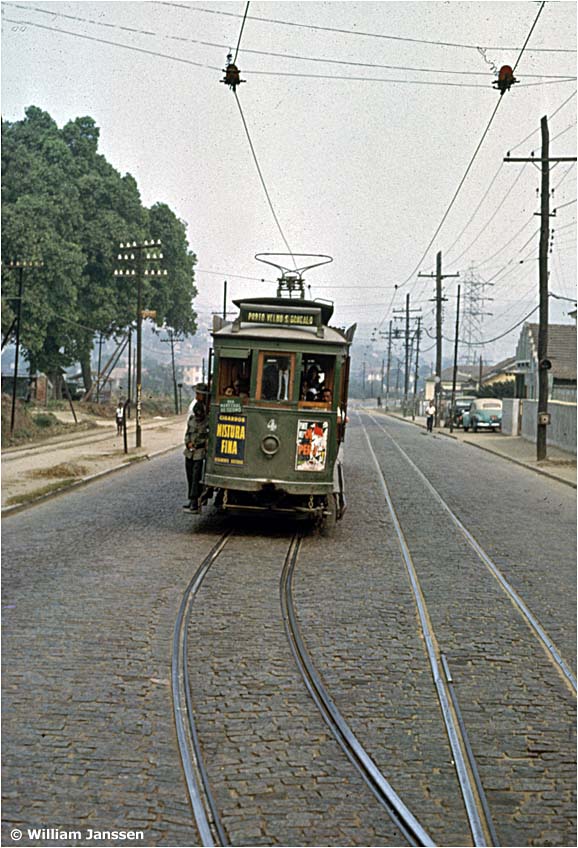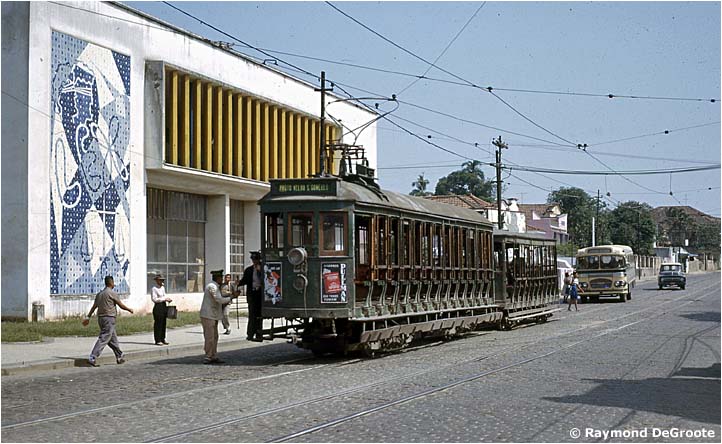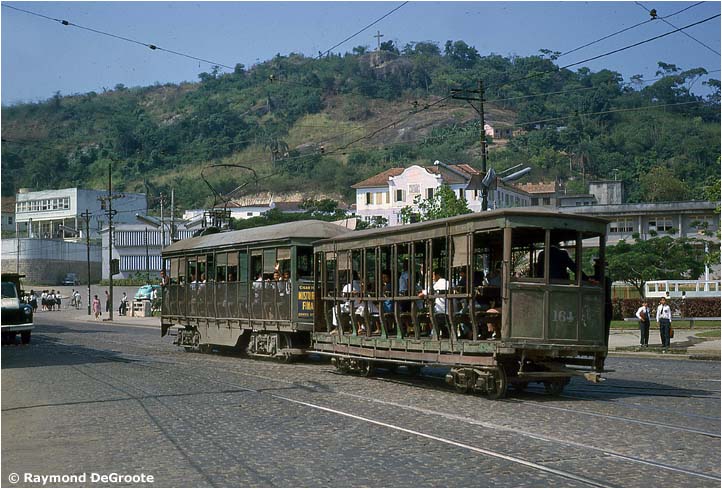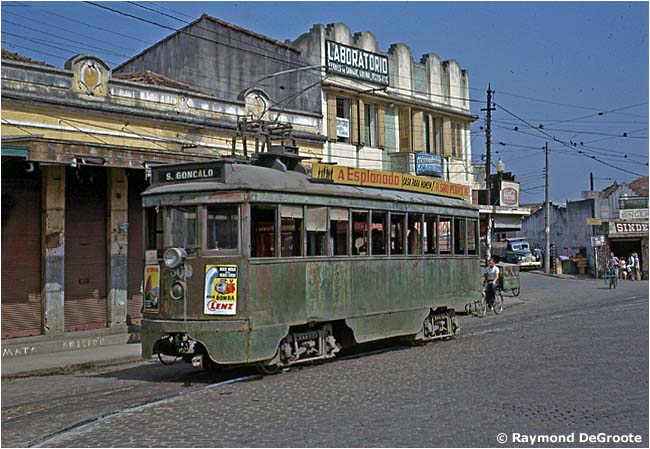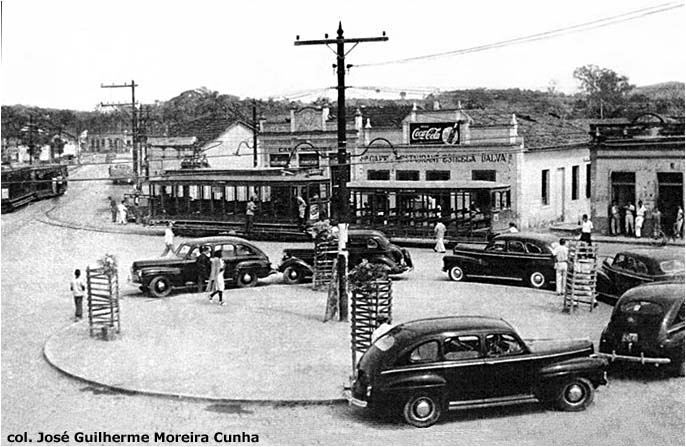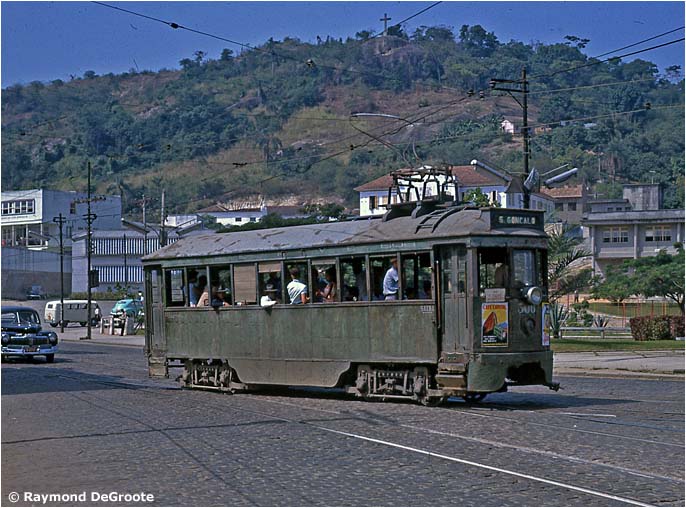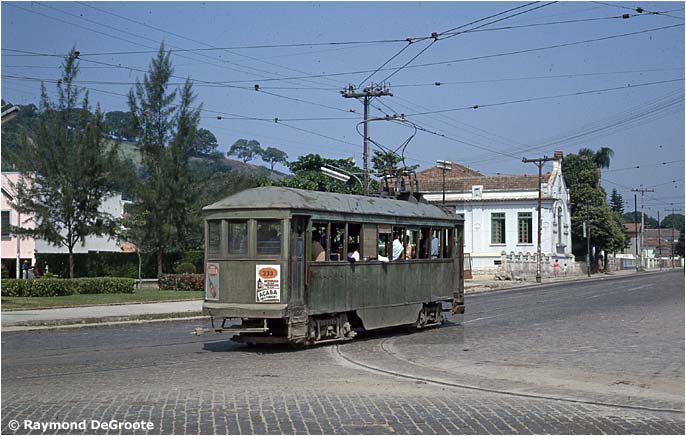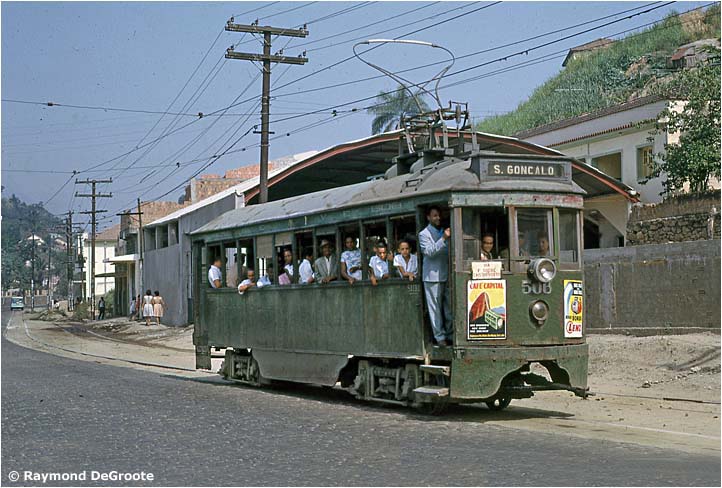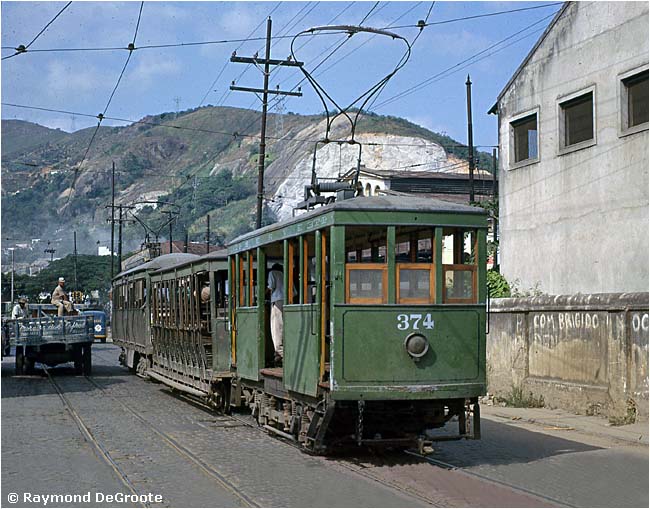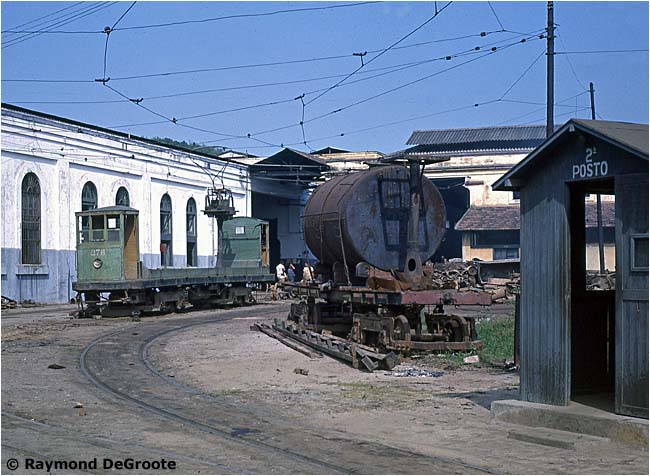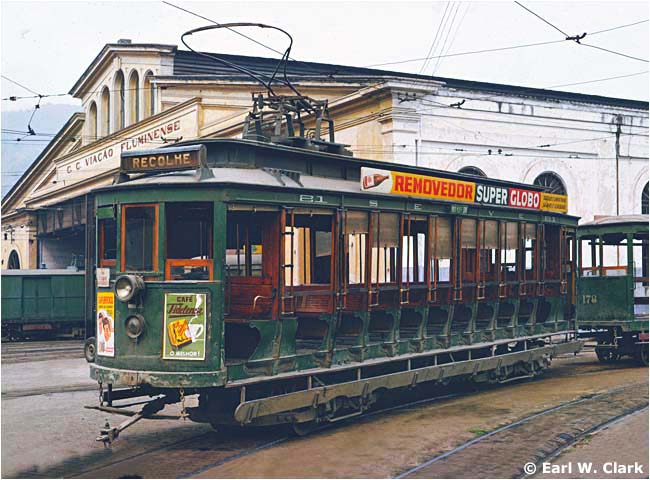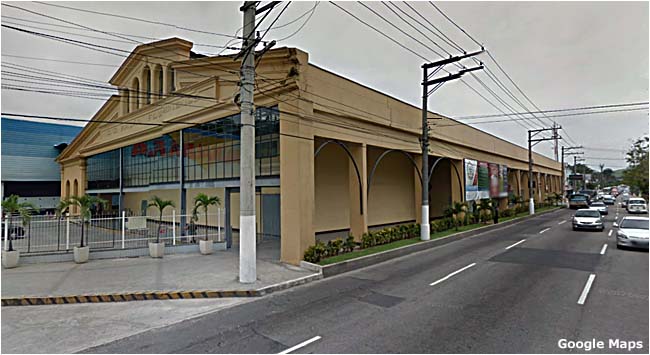The Trams & Trolleybuses of NITERÓI & SÃO GONÇALO Brazil by Allen Morrison
|
On Guanabara Bay across from Rio de Janeiro, Niterói was the capital of Rio de Janeiro state until 1975, when Guanabara state was dissolved and Rio de Janeiro city became the new state capital [see area map]. São Gonçalo was originally a district within Niterói, but acquired municipal status in 1922. Niterói's population was about 50,000 in 1910, is 500,000 today. São Gonçalo today has twice that population, over a million, and is the second most populous city in the state. Niterói had a horse-drawn tramway before it had a steam railroad. Scheduled boat service across the bay began in the early 19th century, and until the Rio-Niterói bridge opened in 1974 local transportation focused on the ferryboat terminal, the "Barcas," on Avenida Visconde do Rio Branco [see route map]. The Ferro Carril Nictherohyense inaugurated a 1050 mm gauge horsecar line from the Barcas to São Domingos on 9 October 1871, and to Icaraí on 1 November. The tram in this undated postcard view is signed "S. Domingos", but the location seems to be Icaraí [col. AM]:
On 10 March 1872 trams reached Barreto, where the city's first steam railroad was building its terminal [see map]. The Ferro Carril de Niterói, later absorbed by the Estrada de Ferro Cantagallo and then by the British-owned Leopoldina Railway, opened a 25 km steam line to Villa Nova (today called Itambi) on 1 December 1874. Ferro Carril Nictherohyense was absorbed by Trilhos Urbanos de Nictheroy in 1877 and by the Companhia Carris Urbanos on 1 July 1883. Recent studies have revealed that the latter company obtained permission the next day to operate a battery tram designed by a Portuguese named Carlos Basto. The car went forward and backward at 10 kph, even on grades of 6%, and seems to have been placed in revenue service on the outer end of the new Fonseca tram line on 7 October 1883. Emperor Pedro II rode it the following 13 March [scan of text on p. 122 of the Relatorio apresentado á Assembléa Legislativa Provincial do Rio de Janeiro na abertura da primeira sessão da vigésima quarta legislatura em 8 de agosto de 1884. Rio de Janeiro, 1884]:
[On 13 March H. M. the Emperor graciously attended the electric traction experiments conducted by the Portuguese citizen Carlos Basto at the far end of this railway's Fonseca line...] Newspapers report problems, but apparently the pioneer electric car continued to run along Alameda São Boaventura until at least February 1885. Unfortunately, no pictures of the operation could be found. Horsecar expansion continued and a line reached Neves, 8 km from the ferry terminal, on 11 October 1885 [see map]. 21 October 1892 saw the organization of the Companhia Cantareira e Viação Fluminense, which would operate both the trams in Niterói and the ferryboats on Guanabara Bay for the next 60 years. Here are some of the tickets used by its "Carril" or "Carris" (railway) division [col. AM]:
The neighboring municipality of São Gonçalo had its own transport lines. At the turn of the century two steam railways built stations near the end of the horsecar line in Neves [see map]. On 5 August 1899 the Tramway Rural Fluminense inaugurated a 15 km steam-powered line to Alcântara, which provided local service along the streets paralleling the Leopoldina Railway. The Estrada de Ferro de Maricá, which began construction at Maricá, reached Neves in 1900. The two steam railways, which both used meter gauge, ran side-by-side down Rua Oliveira Botelho. TRF later replaced its bondes a vapor with gasoline models [col. AM]:
An hydraulically-powered inclined plane railway opened in 1906 on the hillside behind the Colégio Salesiano in Niterói's Santa Rosa district [see map]. This undated postcard view may show the inauguration [col. AM]:
Another early view of Icaraí Beach [see map]. That's the "Pedra do Índio" (Indian Rock) on the horizon [postcard, col. AM]:
CCVF was acquired in 1912 by the Leopoldina Terminal Company, a subsidiary of the British-owned Leopoldina Railway. CCVF purchased the Tramway Rural Fluminense in 1921 and electrified the São Gonçalo-Alcântara section of its line in 1924. Electrification of the inner portion of the route, from Neves to São Gonçalo, was completed in 1925 and thereafter electric trams ran all the way from the Barcas in Niterói to Alcântara, a distance of 21 km. Both suburban lines, unfortunately, had long single-track sections that limited frequency of service. Electric Bond & Share, the American corporation, purchased the electric utilities in Niterói in 1927, but not the tram system. CCVF began to rebuild open cars into closed models in 1944 and the IBGE report for 1945 shows 93 passenger motor cars, 71 passenger trailers and 28 freight cars on 97 km of track. This motor car and trailer, photographed at the ferry terminal in 1947, are headed for Largo do Moura on the Fonseca line [see map] [Carlheinz Hahmann]:
In 1953 CCVF's tramway operations were transferred to a new state agency, Serviço de Viação de Niterói a São Gonçalo, or "SERVE", which purchased 45 VETRA trolleybuses from France. The poster below, from early 1953, announced that the first 11 vehicles had arrived in February and seven more in March [col. Marcelo Almirante]:
SERVE replaced Icaraí trams with trolleybuses on 21 November 1953 [see map]. It was Brazil's third trolleybus system, preceded only by lines in São Paulo and Belo Horizonte; it predated the Rio de Janeiro installation by eight years. The Niterói trolleybus in this VETRA publicity image is superimposed over Rio de Janeiro. Niterói is at the other end of the trolley poles [col. AM]:
The rare photograph below shows two VETRA trolleybuses on Praia de Icaraí (Icaraí Beach) – the opposite of the view above [see map]. Note Pão de Açúcar (Sugar Loaf) mountain across the bay [Ney Rocha]:
SERVE rebuilt some of its trams with this streamlined design. Was the livery inspired by the trolleybus scheme? The photograph was taken in the Santa Rosa district in January 1957 [see map] [William Janssen]:
On 22 May 1959 Niterói residents revolted against poor ferryboat service and set fire to the Barcas terminal, several ferryboats, numerous trams and trolleybuses, the company offices and the home of the Carreteiro family that controlled maritime transportation. Six people died. 118 more were injured. The transport company across the bay in Rio de Janeiro began to eliminate trams from its beach lines in 1960, and SERVE did the same in Niterói. By 1961 it had converted all the tram lines in the residential districts south of the Barcas terminal to trolleybus operation. It was probably also during this period that SERVE cut the Alcântara suburban line back to Praça Luís Palmier [see map]. Learning of the blitz, tramway enthusiasts in North America and Europe flocked to Brazil to ride and photograph the remains. Most of the pictures shown below were taken by Chicago enthusiast Raymond DeGroote on 25 April 1963, when only the northside lines were left: the urban routes to Ponta d'Areia and Largo do Moura, and the suburban lines to São Gonçalo. The São Gonçalo routes both terminated at a loop at Praça Luís Palmier. Cars signed "S. Gonçalo" went via Sete Pontes; cars on the other route were marked "Porto Velho S. Gonçalo"; "Neves" was a short turn. "Recolhe", seen on tram 21 below, meant Out of Service [Raymond DeGroote]:
The shell of the old Barcas terminal, destroyed in the 1959 riot [Raymond DeGroote]:
Motor tram 26 pulls trailer 139 past the same corner on Av. Rio Branco, headed for Porto Velho and São Gonçalo [see map] [Raymond DeGroote]:
Number 26 passes the courthouse on Rua Dr. Francisco Portela, near its junction with Rua Coronel Serrado in São Gonçalo [see map]. View is west [Raymond DeGroote]:
Motor tram 517 and trailer 164 at the junction in São Gonçalo [see map]. Tracks turning onto Rua Coronel Serrado are barely visible under the shadow on the right [Raymond DeGroote]:
The other side of the loop – the "Rodo de São Gonçalo" – at Praça Luís Palmier. View is west. The tram train extreme left is arriving at the spot shown in the previous photograph [col. José Guilherme Moreira Cunha, courtesy Zeca Pinheiro]:
Single-end tram 506 heading back to Niterói, turning left from Rua Coronel Moreira César onto Rua Coronel Serrado [see map]. The car is still in São Gonçalo but is already fully loaded with passengers. They look like they might be having a good time, though. Brill model 76-E trucks [Raymond DeGroote]:
Trolleybuses continued to run on Niterói's south side, but a hurricane in January 1966, and another storm in January 1967, damaged the infrastructure. The trackless trolley system finally closed on 10 November 1967. The photograph below shows the old tram and trolleybus depot on Rua Marechal Deodoro in 2012 [Google Maps "Street View"]:
The last photograph shows the Pedra do Índio and Praia de Icaraí today [DiMonteiro, Wikimedia Commons]: |
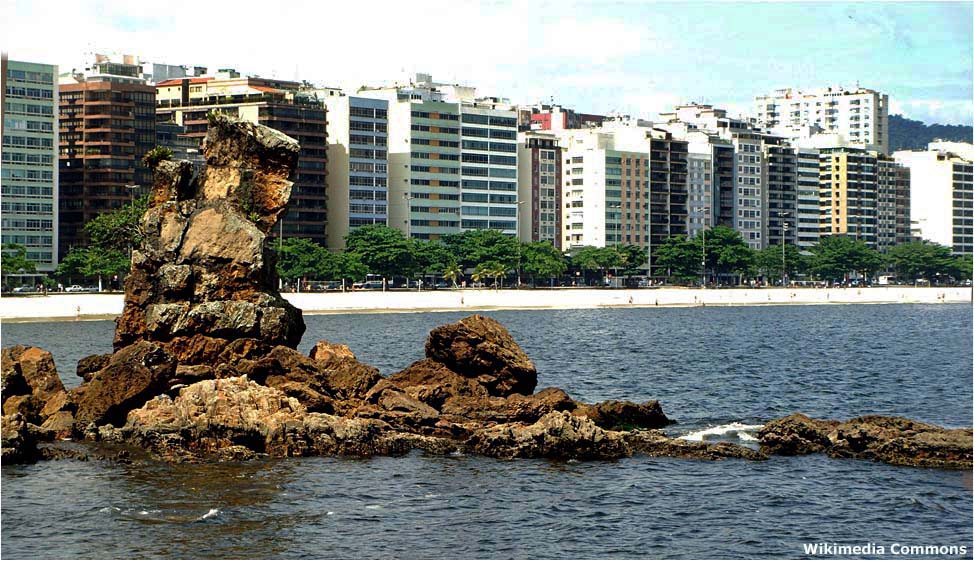
BIBLIOGRAPHY
Rio de Janeiro (Provincia). Relatorio apresentado á Assembléa Legislativa Provincial do Rio de Janeiro na abertura da primeira sessão da vigésima quarta legislatura em 8 de agosto de 1884. Rio de Janeiro, 1884. The "Carris-Urbanos de Nictheroy" text on p. 122 describes Emperor Pedro II's visit to the battery-powered tram line. This text is reproduced above. "Bonds Electricos" in O Fluminense (Niterói), 1906/11/1, 1-2. Excellent, detailed description of the new electric tramway installation. The report claims that the car bodies came from "Saint-Louis" and the meter-gauge trucks from the "Brill Company" (Philadelphia). But no clear confirmation of these orders could be found in the records of St. Louis Car Co. and J. G. Brill. The author believes that the car bodies were the result of an unidentified order for "35 cars" placed with SLCC on 2 February 1906 by Rio de Janeiro Tramway, Light & Power Co. The latter apparently changed its mind and transferred the cars to Niterói. There was a similar strange transfer a few years later. On 4 June 1920 Companhia Cantareira e Viação Fluminense placed an order with Brill for three 13-bench passenger motor cars and two 13-bench passenger trailers. But those five trams inaugurated the Estrada de Ferro Elétrica Votorantim in 1922 in Sorocaba. The "Rio de Janeiro" report in The Brazilian Review (London), 6 November 1906, p. 1021, briefly describes the inauguration of the electric tramway and the retirement of Governor Nilo Peçanha the following day. "Companhia Cantareira e Viação Fluminense" in Brazil-Ferro-Carril (Rio de Janeiro), 1913/4/30, 151-3. Lengthy report describes the tramway system and its rolling stock. Delivery of equipment must have been slow for in 1912, six years after inauguration, there were still only five 10-bench passenger cars, six 13-bench passenger cars, and six motorized work cars in service. The data could be erroneous. Carlos Aenishänslin. Plantas das Cidades de Rio de Janeiro e Nictheroy. Aarau (Switzerland), 1915. Superb color map, at scale 1:22,200, shows the Niterói tram lines in detail. The São Gonçalo area is not included. Brazil. Serviço Geográphico do Exército. "Niterói" (1933) and "São Gonçalo" (1934) topographic maps show the entire tramway system, in both cities, at scale 1:50,000. Used as the base map for the route map drawn for this webpage. Júlio Pompeu de Castro Albuquerque. Álbum de Nichteroy. Niterói, 1925. Valuable two-page survey with precise data on tramway development . José Mattoso Maia Forte. Notas para a História de Niteroy. Niterói, 1935. Interesting tramway data on pp. 128-129 of the "Melhoramentos Urbanos" chapter. Luiz Palmier. São Gonçalo Cinquentenário. Niterói, 1940. The chapters on "Transportes Urbanos" on pp. 92-94 and "O Bonde a Vapor" on pp. 42-43 are excellent and the best sources of information about tramways in São Gonçalo. There are also wonderful, rare illustrations on p. 43 and on the unnumbered pages between 32 and 33. The former terminus of the tram lines in São Gonçalo is named Praça Luís Palmier. José Mattoso Maia Forte. O Município de Niterói. Rio de Janeiro, 1941. The "Viação Urbana" chapter on pp. 225-226 expands the author's tramway history noted above. There is a fascinating list of the tramway routes in both Niterói and - unusual - São Gonçalo. Everardo Backheuser. Minha Terra e Minha Vida. Rio de Janeiro, 1942. Description of the mule-powered lines, pp. 29-41. John Baird. Companhia de Cantareira e Viação Fluminense. Unpublished route map and route list of the Niterói-São Gonçalo tramway system in 1949. Extraordinary material from Latin America's first tramway enthusiast. Armando de Oliveira Fernandes. A Indústria da Energia Elétrica no Brasil. Rio de Janeiro, 1953. A valuable summary of government reports and newspaper articles concerning the 1883 battery-powered tramway, pp. 16-18. Strangely, the researchers missed the emperor's visit noted in the first item above. Guia Geral da Cidade de Niterói, 1960. Itineraries of tram and trolleybus routes. Raymond DeGroote. Serviço de Viação de Niterói e São Gonçalo. Unpublished map of the track layout – all track details – of the tramway system as the author/photographer observed it on 25 May 1963. A fantastic document. "Morre uma Tradição" in O Fluminense (Niterói), 1 VIII 1964, p. 1. Front-page article about the closure of the tramway system. Josef Barat. Estrutura Metropolitana e Sistema de Transportes. Rio de Janeiro, 1975. "Bondes nas cidades de Niterói e São Gonçalo," pp. 164-169. Charts comparing tram traffic in the mid-20th century. Carlos Wehrs. Niterói: Cidade Sorriso. Rio de Janeiro, 1984. The section on trams, pp. 243-249, quotes Bastos material from the 1953 Fernandes text, above, then briefly describes the development of the electric tram and bus systems. Allen Morrison. The Tramways of Brazil: A 130-Year Survey. New York, 1989. The Niterói chapter, pp. 116-119, contains history, six photographs and a system map. Carlos Wehrs. Capítulos da Memória Niteroiense. Rio de Janeiro, 1989. "Primeiros Bondes Elétricos de Niterói", pp. 46-56. Details of early horsecar operation and the inauguration of the electric tramway and the Colégio Salesiano inclined plane. Much of the material comes from the 1906 Fluminense article cited above. Cristina da Fonte Pontes; Salvador Mata e Silva. O Bonde em Niterói. Niterói, 2008. A small 117-page booklet with data from the 1989 Wehrs book cited above. Route descriptions, but no map. Much of the material presented is general tram folklore. Ralph Mennucci Giesbrecht. Estações Ferroviárias do Brasil. History, maps and photographs of Brazilian railroads and stations. The Rio de Janeiro page provides excellent information about railroads in the Niterói-São Gonçalo region.
The author wishes to express his gratitude to Earl W. Clark, Raymond DeGroote, the late William C. Janssen, Wanderley Duck, Ayrton Camargo e Silva and Zeca Pinheiro for the assistance, information and illustrations that they provided for this page.
___________________________
Also see And my index of If you have comments, criticism or suggestions, This site was placed online on 10 December 2012 Copyright © 2012-2112 Allen Morrison As fotos coloridas desta página são protegidas pela Lei do Direito Autoral (Lei N° 9.610 de 19 de Fevereiro de 1998) e não podem ser reproduzidas sem a expressa autorização do autor. |
